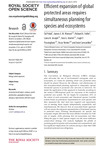Efficient expansion of global protected areas requires simultaneous planning for species and ecosystems
| dc.contributor.author | Polak, Tal | en_US |
| dc.contributor.author | Watson, James E.M. | en_US |
| dc.contributor.author | Fuller, Richard A. | en_US |
| dc.date.accessioned | 2016-10-11T05:37:38Z | |
| dc.date.available | 2016-10-11T05:37:38Z | |
| dc.date.issued | 2015 | en_US |
| dc.identifier.other | HPU4160552 | en_US |
| dc.identifier.uri | https://lib.hpu.edu.vn/handle/123456789/23630 | en_US |
| dc.description.abstract | The Convention on Biological Diversity (CBD)’s strategic plan advocates the use of environmental surrogates, such as ecosystems, as a basis for planning where new protected areas should be placed. However, the efficiency and effectiveness of this ecosystem-based planning approach to adequately capture threatened species in protected area networks is unknown. We tested the application of this approach in Australia according to the nation’s CBD-inspired goals for expansion of the national protected area system. | en_US |
| dc.format.extent | 11 p. | en_US |
| dc.format.mimetype | application/pdf | en_US |
| dc.language.iso | en | en_US |
| dc.subject | Biology | en_US |
| dc.subject | Ecology | en_US |
| dc.subject | Ecosystem-based targets | en_US |
| dc.subject | Surrogacy | en_US |
| dc.subject | Spatial prioritization | en_US |
| dc.subject | Geographical range size | en_US |
| dc.subject | Adequacy | en_US |
| dc.subject | Representation | en_US |
| dc.title | Efficient expansion of global protected areas requires simultaneous planning for species and ecosystems | en_US |
| dc.type | Article | en_US |
| dc.size | 610KB | en_US |
| dc.department | Education | en_US |
Files in this item
This item appears in the following Collection(s)
-
Education [806]

